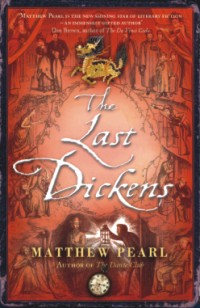|
Book Review
Tale of Dickens' mysterious Unfinished book, a ripping read
"The Last Dickens" is novelist Matthew Pearl's re-imagining of the last days of Charles Dickens' life, and the mysteries left in the wake of his death.
Adam Woog
 Charles Dickens, it seems, is hot stuff again. (Of course, some of us think that Dickens has always been hot stuff.) Earlier this year came Dan Simmons' "Drood," which imagined Dickens and Wilkie Collins chasing a "real-life" character from Dickens' final, unfinished work: "The Mystery of Edwin Drood." Charles Dickens, it seems, is hot stuff again. (Of course, some of us think that Dickens has always been hot stuff.) Earlier this year came Dan Simmons' "Drood," which imagined Dickens and Wilkie Collins chasing a "real-life" character from Dickens' final, unfinished work: "The Mystery of Edwin Drood."
Hard on its heels comes another intricate and carefully nuanced novel about the great man: Matthew Pearl's "The Last Dickens."
Pearl is a young writer who specializes in historical literary fiction. (Previous novels include "The Dante Club" and "The Poe Shadow.") His work wears its deep research lightly, combining real-life figures and bookish references with robust prose and storytelling.
Like "Drood," Pearl's new book explores the enduring enigma of that unfinished novel. More specifically, it focuses on Dickens' status as a wildly popular superstar of his day. In that vein, it examines two issues that are still very much with us: the pitfalls of celebrity and repeated violations of what is now called "intellectual property."
The main action of "The Last Dickens" opens in the summer of 1870, shortly after the author's death. His public is in mourning these are the days when Dickens' American fans waited anxiously at the dock for the arrival by ship of their beloved author's latest work.
Beyond the grief, Dickens' death has created a more immediate problem. "Drood," like much of Dickens' work, has been serialised, and its final chapters are missing. It is uncertain whether or not the writer ever finished them.
James Osgood, one of the partners in Dickens' American publishing company, is eager to get the advance proofs of the new book and locate any missing chapters. This quest is crucial not only for the reading public, but for the coffers of the publishers: the lack of copyright laws during the period portrayed in this book means that anyone can pirate the stuff. Plenty of unsavory types want to do just that. Osgood sends a young copyboy to the Boston docks to meet the ship carrying advance proofs. When the boy is killed and the proofs go missing, the chase begins. It soon leads Osgood to London in the company of his strong-minded secretary, who is also the boy's sister.
In England they have a number of ripping adventures, including visits to the Dickens family and to a ghastly opium den. These vivid passages are, well, straight out of Dickens, and Pearl does a terrific job of evoking the fizz of life in Victorian London.
As all this unfolds, a parallel story takes place earlier in time. It's 1867, and Dickens is on a speaking tour of America. Everything is going well, with a few exceptions notably a disturbed, obsessive woman who is stalking the writer. Not to mention the mysterious stranger with the lethal walking stick ...
Less successful than these twinned stories is a subplot involving Dickens' son, a military officer in India. The subplot proves vital to the book's conclusion, but it also seems thin compared to the strength of the two main story lines.
There are occasional other lapses, including the hoary old trick of having a villain admit all and explain his wickedness in a lengthy speech to the good guys.
Overall, though, Pearl remains notably sure-footed as he lays out his complex tale. Of course, the book's conclusion can't be revealed here though it's safe to say that Pearl has constructed an ingenious ending to the enduring mystery of the last Dickens.
This review first appeared in
The Seattle Times.
Copyright
(R) thedailystar.net 2009 |
